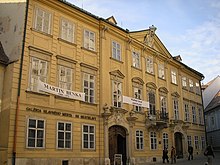Mirbach Palace
The four-wing, two-story building, which ranks among the most beautiful and best-preserved architectural monuments of the mentioned style period in Slovakia, was named after the last owner, Baron Dr. Emil Mirbach.
The well-known Bratislava historian Tivadar Ortvay (1843 - 1916) states in one of his writings that the building standing here was decorated with the city coat of arms, and its core consisted mostly of wooden construction.
Bel continues with a description of an event that significantly affected the fate of the building - on October 23, 1733, the house burned down.
In addition, we learn from Bel's description that the rooms in the palace were used several times, e.g. for the accommodation of military officers or that the basement spaces are used for wine storage.
The well-known historian and cartographer Ján Matej Korabinský left a message about this fact in his work Beschreibung der königlich – ungarischen Haupt-, Frey – und Krönungstadt Pressburg (Description of the Hungarian royal, capital and coronation city of Prešpork) from 1781.
Several experts pointed to the foreign origin of the designer; there was a reflection on the work of the prominent Austrian architect Franz Anton Hillebrandt.
The result of the construction was a representative urban baroque palace with rich rococo stucco ornamental decoration of the facades and furnishing of the interior spaces, with a high standard of execution of artistic and craft works.
Currently, the interior of the palace is structurally adapted to museum purposes, despite this, two rooms on the first floor with wooden paneling on the walls, in which rare period graphic sheets from the 18th century are installed, have been preserved in their original condition.
A four-winged, two-story palace with gable roofs built on an irregular trapezoid plan architecturally completes the space at the northern end of Františkánske Square.
Its dominant feature is a fountain with a copy of the sculpture Triton and a nymph, the work of the leading Bratislava sculptor Viktor Tilgner.
The main, strictly symmetrical facade, oriented towards Františkánské náměstí, is decorated with delicate, airy rockeries of imaginative shapes.
In the middle of the facade leads a striking rizalite ending in a massive tympanum, on which there is a cartouche with a pair of oval shields under the count's crown.
